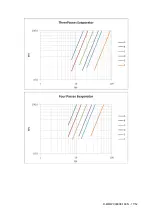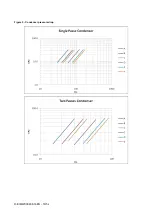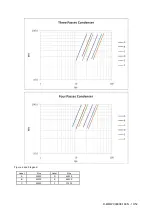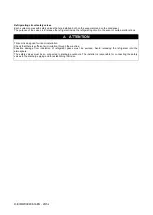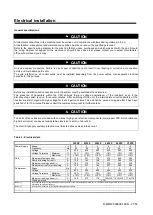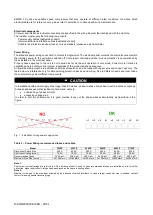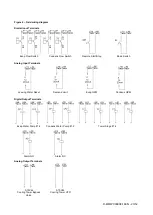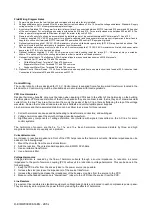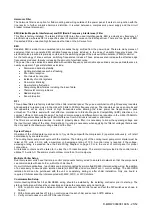
D-EIMWC00908-16EN - 25/52
Harmonic Filter
The harmonic filter is an option for field mounting and wiring outside of the power panel. It works in conjunction with the
line reactor to further minimize harmonic distortion. It is wired between a compressor’s power supply and the circuit
breaker (manual disconnect).
EMI (Electro Magnetic Interference) and RFI (Radio Frequency Interference) Filter
This filter is factory-installed. The terms EMI and RFI are often used interchangeably. EMI is actually any frequency of
electrical noise, whereas RFI is a specific subset of electrical noise on the EMI spectrum. There are two types of EMI.
Conducted EMI is unwanted high frequencies that ride on the AC wave form.
EMI
Radiated EMI is similar to an unwanted radio broadcast being emitted from the power lines. There are many pieces of
equipment that can generate EMI, variable frequency drives included. In the case of variable frequency drives, the
electrical noise produced is primarily contained in the switching edges of the pulse width modulation (PWM) controller.
As the technology of drives evolves, switching frequencies increase. These increases also increase the effective edge
frequencies produced, thereby increasing the amount of electrical noise.
The power line noise emissions associated with variable frequency and variable speed drives can cause disturbances in
nearby equipment. Typical disturbances include:
Dimmer and ballast instability
Lighting disturbances such as flashing
Poor radio reception
Poor television reception
Instability of control systems
Flow meter totalizing
Flow metering fluctuation
Computer system failures including the loss of data
Thermostat control problems
Radar disruption
Sonar disruption
RFI
Three-phase filters are factory installed in the chiller electrical panel. They use a combination of high frequency inductors
and capacitors to reduce noise in the critical 150 kHz to 30 MHz frequency range. The inductors act as open circuits and
the capacitors act as short circuits at high frequencies while allowing the lower power line frequencies to pass
untouched. The filters assist with cost effective compliance to Electro Magnetic Compatibility (EMC) directives, in a
compact, efficient, light-weight design. The high common mode and differential mode reduction in the critical 150kHz to
30MHz frequencies assures that potential interference from AC drives is reduced or eliminated.
The filters are current-rated devices. In order to properly size a filter, it is necessary to know the operating voltage and
the input current rating of the drive. No derating or re-rating is necessary when applying the filter at voltages that are less
than or equal to the maximum voltage listed on the filter.
System Pumps
Operation of the chilled water pump can be to 1) cycle the pump with the compressor, 2) operate continuously, or 3) start
automatically by a remote source.
The cooling tower pump must cycle with the machine. The holding coil of the cooling tower pump motor starter must be
rated at 115 volts, 60 Hz, with a maximum volt-amperage rating of 100. A control relay is required if the voltage-
amperage rating is exceeded. See the Field Wiring Diagram on page 30 or in the cover of control panel for proper
connections.
All interlock contacts must be rated for no less than 10 inductive amps. The alarm circuit provided in the control center
utilizes 115-volts AC. The alarms must not draw more than 10-volt amperes.
Multiple Chiller Setup
Dual compressor units have their main control components factory wired to an internal network so that the components
can communicate with each other, within the chiller itself.
On multi-chiller applications, two chillers can be interconnected by simple field RS485 interconnecting wiring, the addition
of an accessory communication isolation board(s) 485OPDR, and some MicroTech II control settings. The 485OPDR
isolation board can be purchased with the unit or separately, during or after chiller installation. Only one board is
required. Chillers cannot be interconnected with WSC, WDC, or WCC chillers.
Communication Setup
Interconnecting MicroTech II pLAN RS485 wiring should be installed by the installing contractor prior to start-up. The
start-up technician will check the connections and make the necessary set point settings.
1. With no pLAN connections between chillers, disconnect chiller control power and set the DIP switches as shown in
Table 3.
2. With all manual switches off, turn on control power to each chiller and set each OITS address.
3. Verify correct nodes on each OITS Service Screen.
Summary of Contents for EWWD320
Page 16: ...D EIMWC00908 16EN 16 52 Figure 4 Evaporator pressure drop...
Page 17: ...D EIMWC00908 16EN 17 52...
Page 18: ...D EIMWC00908 16EN 18 52 Figure 5 Condenser pressure drop...
Page 34: ...D EIMWC00908 16EN 34 52 Figure 12 Compressor overview...
Page 50: ...D EIMWC00908 16EN 50 52...
Page 51: ...D EIMWC00908 16EN 51 52...







